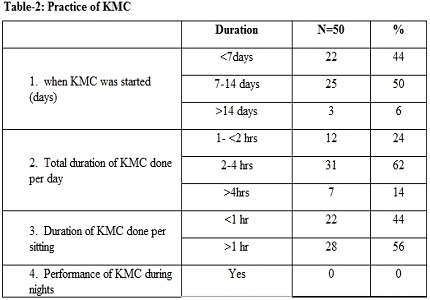Implementation of Kangaroo Mother care for low birth weight babies: supportive factors and barriers perceived by mothers
Abstract
Introduction: Kangaroo mother care (KMC) consist of prolonged skin to skin contact between mother and infant and exclusive breastfeeding. It was originally developed to prevent hypothermia and to enhance bonding between mother and Infant.
Methods: It was a questionnaire based cross sectional observational study. Questionnaire was prepared by authors in local native language and was validated by experts; mothers with babies fit for KMC were enrolled and interviewed with a predefined proforma having both open and close ended questions with their demographic details.
Results: More than half (54%) of the mothers had no knowledge about KMC during their pregnancy. About 46% of them were made aware by their doctors (82.6%) or their relatives (mother/elder sisters). Most mothers get help from nursing staff (98%) and they felt that environment was conducive for the practice of KMC (70%) and they got help from other mothers (74%) and family members (84%). Barriers were pain due to stitches (44%), unfavorable condition to perform KMC (29.4%), fatigue/fear while performing KMC (16.3%), difficulty due to twins (9.8%). Pain/fatigue (53.75%) is the barrier to KMC according to the mothers; about 30% mothers felt temperature as a barrier while practicing KMC.
Conclusion: They believed that their babies will become healthier and can feed easier after initiation of KMC. Inspiration from family members or other mothers are also an enabler of KMC. Lack of support from family members, other mothers as well as from nursing staff in some cases, this barrier can be improved by training of their family members.
Downloads
References
2. Seidman G, Unnikrishnan S, Kenny E, Myslinki S, Cairns-Smith S, Mulligan B, et al., Barriers and Enablers of Kangaroo Mother Care Practice: A Systematic Review. PLoS One. 2015 May 20;10(5):e0125643. doi: 10.1371/journal.pone.0125643. eCollection 2015. [PubMed]
3. Conde-Agudelo A, Diaz-Rossello JL. Kangaroo mother care to reduce morbidity and mortality in low birth weight infants. Cochrane Database Syst Rev. 2014 Apr 22;(4):CD002771. doi: 10.1002/14651858.CD002771. [PubMed]
4. Grace J Chan, Amy S Labar, StephenWall, Rifat Atun. Kangaroo mother care: a systematic review of barriers and enablers. Bulletin of the World Health Organization 2016;94:130-141J. doi: http://dx.doi.org/10. 2471/BLT.15.157818.
5. Stikes R Barbier D. Applying the plan -do-study -act model to increase the use of kangaroo care. J Nurs Manag. 2013. January; 21 (21) :70-78 .10.1111/jonm. 12021
6. Gathwala G, Singh B, Singh J:Effect of kangaroo mother care on physical growth, breast feeding and its acceptability. Trop Doct. 2010 Oct;40(4):199-202. doi: 10.1258/td.2010.090513. Epub 2010 Jul 28. PubMed PMID: 20667921. [PubMed]
7. Mehboobeh N, Sedigheh T, Majid M, Fatemesadat M. the implementation of kangaroo mother care and nurses perspective of barriers in Iranian NICUs. Iran J Nurs Midwifery Res. 2016 Jan-Feb; 21(1): 84–88. doi: 10.4103/1735-9066.174753.
8. Samuel et al. Perception and practice of Kangaroo mother care after discharge from hospital in Kumasi, Ghana: A longitudinal study. BMC Pregnancy and Childbirth2011:99 https://doi.org/10.1186/1471-2393-11-99
9. Brimdyr K, Widstrom AM, Cadwell K, Svensson K, Turner-Maffei C. A Realistic Evaluation of Two Training Programs on Implementing Skin-to-Skin as a Standard of Care. J Perinat Educ. 2012 Summer; 21(3): 149–157.doi: 10.1891/1058-1243.21.3.149.
10. Feldman R, Weller A, Sirota L, Eidelman AI. Testing a family intervention hypothesis: the contribution of mother-infant skin-to-skin contact (kangaroo care) to family interaction, proximity, and touch. JFam Psychol 2003, 17: 94–107.
11. Mohammed El-Nagger NSAEA H, Mahmoud Zaki Hassan S. Effect of kangaroo mother care on premature infants' physiological, behavioral, and psychosocial outcomes in Ain Shams maternity and Gynecological Hospital, Cairo, Egypt. Life Science Journal 2013: 703–716.
12. Bazzano A, Hill Z, Tawiah-Agyemang C, Manu A, ten Asbroek G, Kirkwood B. Introducing home based skin-to-skin care for low birth weight newborns: a pilot approach to education and counseling in Ghana. Global health promotion 2012, 19: 42–49.
13. Bigelow A, Power M, MacLellan-Peters J, Alex M, McDonald C. Effect of mother/infant skin-to skin contact on postpartum depressive symptoms and maternal physiological stress. J Obstet Gynecol Neonatal Nurs. 2012 May-Jun;41(3):369-82. doi: 10.1111/j.1552-6909.2012.01350.
14. Parmar VR, Kumar A, Kaur R, Parmar S, Kaur D, Basu S, et al. Experience with kangaroo mother care in a neonatal intensive care unit (NICU) in Chandigarh, India. Indian J Pediatr. 2009 Jan;76(1):25-8. doi: 10.1007/s12098-009-0024-2. [PubMed]
15. Solomons N, Rosant C. Knowledge and attitudes of nursing staff and mothers towards kangaroo mother care in the eastern sub-district of Cape Town. South African Journal of Clinical Nutrition 25(1):33-39. January 2012 with 1,170 Reads. DOI: 10.1080/16070658.2012.11734400.
16. Lima G, Quintero-Romero S, Cattaneo A. Feasibility, acceptability and cost of kangaroo mother care in Recife, Brazil. Ann Trop Paediatr. 2000 Mar;20(1):22-6. [PubMed]
17. Kambarami RA, Mutambirwa J, Maramba PP. Caregivers' perceptions and experiences of 'kangaroo care' in a developing country. Trop Doct 2002 Jul;32(3):131-3.
18. Charpak N, Ruiz-Pelaez JG. Resistance to implementing Kangaroo Mother Care in developing countries, and proposed solutions. Acta Paediatr 2006 May;95(5):529-34.
19. Johnson AN. Factors influencing implementation of kangaroo holding in a Special Care Nursery. MCN Am J Matern Child Nurs. 2007. Jan-feb;32(1):25-9.

Copyright (c) 2018 Author (s). Published by Siddharth Health Research and Social Welfare Society

This work is licensed under a Creative Commons Attribution 4.0 International License.


 OAI - Open Archives Initiative
OAI - Open Archives Initiative


